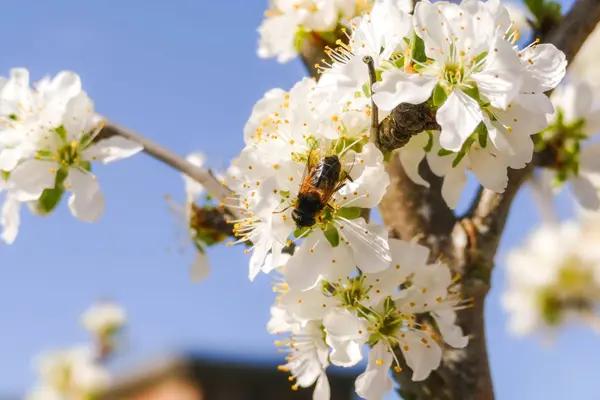Correct Pollination of Your Fruit Trees Increases Crop Size
The main Pollination Checker Tool makes it easy for you to find partners for individual fruit trees, or you can use the old-fashioned tables linked below to see everything at once.
- Apple Pollination Table
- Pear Pollination Table
- Cherry Pollination Table
- Plum Group Pollination Table (Includes damsons, gages, mirabelles, bullaces)

About Fruit Tree Pollination
The common fruit trees of Europe, whether with pips like apples or with stones like plums, have flowers with male and female parts. For fruit to form, the female part (pistil) must receive pollen from the male part (stamen).
A self fertile fruit tree can use its own pollen (with varying degrees of success), but most trees require the pollen from a different and compatible variety of the same species, e.g. a Discovery apple can be pollinated by other apples that are in flower at the same time, but not by other Discovery apples, nor by any pears or cherries.
Pollination groups represent flowering periods, and trees will cross pollinate with other trees in their own group and adjacent groups, e.g. a tree in Pollination Group C will cross pollinate with trees (of the same species) in groups B, C, and D.
Note that the letters can be replaced with numbers, so Group C is the same as Group 3.
There are 3 types of fruit tree fertility:
- Self-fertile / Self-compatible: These pollinate themselves and other trees of the same species that are in flower at the same time. In most cases, they still crop noticeably better when cross-pollinated by another variety; most plums are perfectly self fertile, while almost no apples and maybe one pear truly are.
- Self-sterile / Self-incompatible: Most fruit trees are in this group. They can't pollinate themselves, but do cross-pollinate other varieties of the same species that are in flower at the same time.
- Triploids: A small handful of trees, such as the famous Bramley cooking apple, can't pollinate themselves nor other trees. You therefore need another other tree to pollinate the triploid, plus a third tree to cross-pollinate with that pollinator, because the triploid can't return the favour.
On rare occasion, two specific fruit trees are too closely related to be compatible: our pollination tool takes this into account.
Do I Need Pollination Partners for my Fruit Trees?
In over 75% of the UK, you will have compatible trees already in your neighbourhood, especially when you consider that most crab apples pollinate orchard apples, and wild cherries (gean) pollinate sweet cherries (ornamental cherries, however, generally do not).
The main places where pollination is an issue are remote and windy, typically surrounded by forestry or livestock with few gardens or orchards.

What if I Only Have Space for One Fruit Tree?
First, have a look around your neighbourhood to see what is growing locally, and ask your neighbours with fruit trees which varieties they have. If that doesn't help, then definitely choose a self-fertile tree
Insects (Mainly Bees) are Vital for Pollination
Bees and other insects are necessary to pollen between flowers: even self-fertile trees need them to move their own pollen around their flowers, so an orchard is an ideal place for a beehive, and to encourage wild bees.
In exposed, windy locations, or at high altitude above about 800ft, bees find it hard to fly, so it is even more important to provide habitats and windbreaks to help them out; also, it's best to stick to reliably self-fertile varieties that make the most of limited pollinators.
